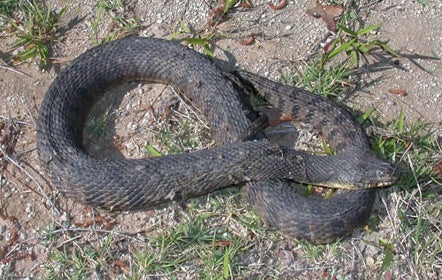SCIENTIFIC NAME:
Nerodia rhombifer
STATUS:
Fairly common to common in western portions of Coastal Plain, extending eastward along Tennessee and Tallapoosa drainages to Macon County. Low Conservation Concern.
DESCRIPTION:
Diamondback water snakes (Nerodia rhombifer) are relatively large, thick bodied snakes. Adult body lengths usually range from 3 to 5 feet. They are greenish-brown to brown in color with dark blotches down their backs. The dark blotches are connected on the sides by alternating dark bars thus forming the diamond-shaped patterns for which the snakes are named. The bellies of diamondback water snakes are yellow with dark spots. Their scales are keeled, which means that they are rough. Like most other North American water snakes, diamondback water snakes are extremely aggressive and will bite hard and repeatedly if cornered. These snakes are non-venomous, however, so their bite is relatively harmless (other than a few scratches and the possibility of infection). Diamondback water snakes often are confused with the venomous, but more docile, cottonmouth, a.k.a. water moccasin (Agkistrodon piscivorus), and are killed needlessly.
DISTRIBUTION:
Populations of diamondback water snakes are concentrated primarily in and around the Mississippi River drainage, but their range extends north to southern Illinois and Indiana, west to Texas, Mexico, and Oklahoma, and eastward into Alabama. In Alabama they are most often found in the Tombigbee and Black Warrior river watersheds in the western half of the state.
HABITAT:
Diamondback water snakes, as their name suggests, inhabit aquatic environments such as rivers, lakes, ponds, marshes, swamps, streams, canals, ditches, and creeks.
FEEDING HABITS:
Diamondback water snakes are diurnal hunters, feeding primarily during daylight hours. They feed on a variety of aquatic species including frogs, toads, tadpoles, small fish, minnows, salamanders, and crayfish. They readily feed on carrion as well.
LIFE HISTORY AND ECOLOGY:
Diamondback water snakes breed in the spring and the females give birth to 14-62 live young from August to October.
REFERENCES:
Cognant, R., and J. T. Collins. 1998. Reptiles and Amphibians Eastern/Central North America. Houghton
and Mifflin Co., Boston, MA. 616 pp.
AUTHOR:
Chas Moore, Wildlife Biologist, Alabama Division of Wildlife and Freshwater Fisheries






